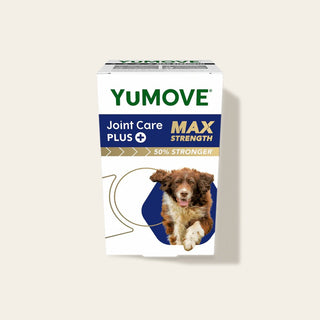

How laser therapy for dogs helps stiff joints
There are lots of treatments available for dogs experiencing joint stiffness, from dietary supplements that promote joint mobility, to gentle exercises designed to maintain a healthy weight.
One of the most common clinical treatments, though, is veterinary laser therapy. This non-invasive joint treatment tackles inflammation, promotes cell regeneration, and improves circulation. It’s no surprise that so many vets recommend it, particularly for senior dogs. Keen to find out more? Here we break down what the treatment involves…
How does laser therapy for dogs work?
Let’s get straight to the science bit. The technical name for laser therapy is Photobiomodulation Therapy, or PBM, but it’s also referred to as Low Level Laser Therapy – LLLT – or red-light therapy.
Essentially, laser therapy uses low-level or cold light energy to target specific areas of stiffness and inflammation. Light emitted at a particular frequency penetrates the soft tissue and speeds up cellular regeneration, which helps your dog’s body to heal more quickly from an injury, or to alleviate the symptoms of joint stiffness brought on by age.

Does dog laser therapy hurt?
Not at all. In fact, laser therapy can be quite a relaxing experience for your canine companion once they’ve settled in, and the only thing they may notice is a warm sensation where the head of the machine is placed. There are no known side effects, and the treatment is risk-free when performed by a qualified vet, using the correct power and duration.
What happens at a laser therapy session?
Once you’ve arrived at your laser therapy session your vet will get your dog in a comfortable position, ready to start. Your dog may be here for a little while, so it’s important that they’re as relaxed as possible. Many vets will allow you to sit with your dog or stay in the room during the treatment if it’s reasonable to, and will provide you with special safety goggles.
Your vet will then use a machine to direct the laser at the area your dog needs help with, slowly moving it over the area during the treatment. The length of time they’ll do this for will depend on the strength of the laser. The higher the power level, the lower the treatment length, and it could be anything from less than a minute to up to ten minutes on each area.

How many sessions will my dog need?
The number of laser therapy sessions your dog needs will be determined by the injury or ailment your vet is treating, as well as the type of laser used. Often though, a treatment course starts with several sessions in succession – perhaps two or three in a week – and tapers down as your dog starts to show an improvement.
Dogs with mild stiffness may see an improvement after just a few sessions, whereas more severe injuries or established mobility problems will take longer to improve.
How do I get laser therapy for my dog?
If you’re worried your dog may be suffering from joint stiffness, always talk to your vet. That way, they can rule out any underlying causes that may be to blame and suggest alternative treatments you may not have considered.
Your vet will be able to advise if laser therapy would help, or they may recommend the treatment if your dog shows signs of joint stiffness at their next health check. Veterinary laser therapy is a safe, proven treatment that’s widely available, so rest assured your beloved dog is in the best hands.
Give your dog’s joints a boost from the inside, with YuMOVE Joint Care PLUS – our triple-action joint support for stiffer, older dogs.



